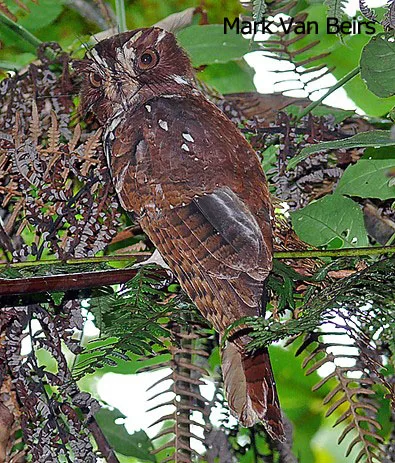
Feline Owlet-nightjar
[order] APODIFORMES | [family] aegothelidae | [latin] aegotheles insignis | [UK] Feline Owlet-nightjar | [FR] Grand aegothele | [DE] Kauzchenschwalm | [ES] Egotelo Grande | [NL] Dwergnachtzwaluw
Subspecies
Monotypic species
Physical charateristics
Two well-defined color morphs-rufous and brown; intermediates also occur. upperparts have sparse whitish streaks or spots and prominent lateral crown stripes; throat is buff or white; underparts have bold whitish spots. Sexes are similar. largest of the Owlet-Nightjars.
| wingspan min.: | 0 | cm | wingspan max.: | 0 | cm |
| size min.: | 28 | cm | size max.: | 32 | cm |
| incubation min.: | 0 | days | incubation max.: | 0 | days |
| fledging min.: | 0 | days | fledging max.: | 0 | days |
| broods: | 0 | eggs min.: | 0 | ||
| eggs max.: | 0 |
Range
Australasia : New Guinea
Habitat
Montane forest, prefers primary forest and eges. Also rierine woodland adjacent to open country and secondary forest.
Reproduction
This species nest in holes, no further data.
Feeding habits
The diet includes insects such as beetles.
Conservation
This species has a very large range, and hence does not approach the thresholds for Vulnerable under the range size criterion (Extent of Occurrence over 20,000 km2 combined with a declining or fluctuating range size, habitat extent/quality, or population size and a small number of locations or severe fragmentation). The population trend appears to be stable, and hence the species does not approach the thresholds for Vulnerable under the population trend criterion (>30% decline over ten years or three generations). The population size has not been quantified, but it is not believed to approach the thresholds for Vulnerable under the population size criterion (over 10,000 mature individuals with a continuing decline estimated to be >10% in ten years or three generations, or with a specified population structure). For these reasons the species is evaluated as Least Concern.

Migration
Presumably sedentary
Distribution map

